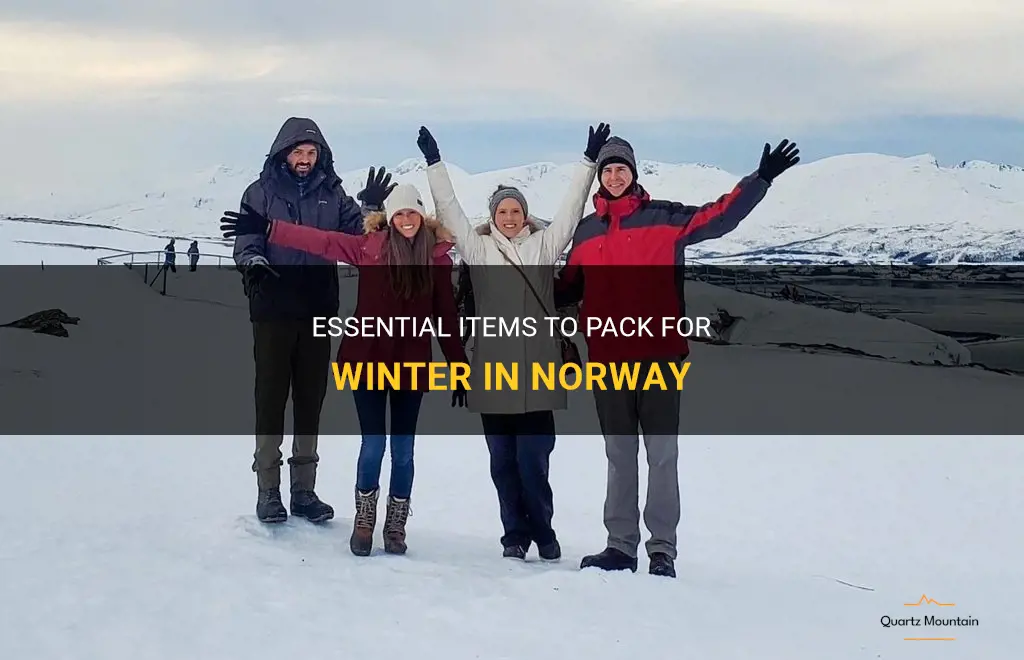
Welcome to winter wonderland! If you're planning a trip to Norway during the chilly season, it's essential to pack strategically. Freezing temperatures, snowstorms, and icy conditions are just some of the obstacles you might face. Don't worry though, because we've got you covered. In this guide, we will walk you through the essential items you need to pack for a winter adventure in Norway. From warm clothing to gear that will keep you safe and comfortable, we'll make sure you're well-prepared to embrace the beauty and challenges of Norwegian winter. So grab your thermal socks and join us on this frosty journey!
| Characteristics | Values |
|---|---|
| Clothing | - Thermals or long underwear |
| - Sweaters or fleeces | |
| - Snow pants or waterproof pants | |
| - Insulated jacket or coat | |
| - Hat, gloves, and scarf | |
| Footwear | - Insulated waterproof boots |
| - Thick socks | |
| Accessories | - Sunglasses |
| - Sunscreen | |
| - Lip balm | |
| - Hand warmers | |
| - Backpack or daypack | |
| - Portable charger | |
| Other | - Personal toiletries |
| - Medications | |
| - Travel documents | |
| - Money and credit cards | |
| - Travel insurance |
What You'll Learn
- What are the essential clothing items to pack for winter in Norway?
- Are there any specific items, such as thermals or down jackets, that are recommended for staying warm in Norway's winter weather?
- What footwear should be included in a winter packing list for Norway, considering potentially icy and snowy conditions?
- Are there any specific accessories or gear that are necessary for winter activities in Norway, such as skiing or snowshoeing?
- Should I pack any specific skincare products or items to protect against the cold and dryness of Norway's winter climate?

What are the essential clothing items to pack for winter in Norway?
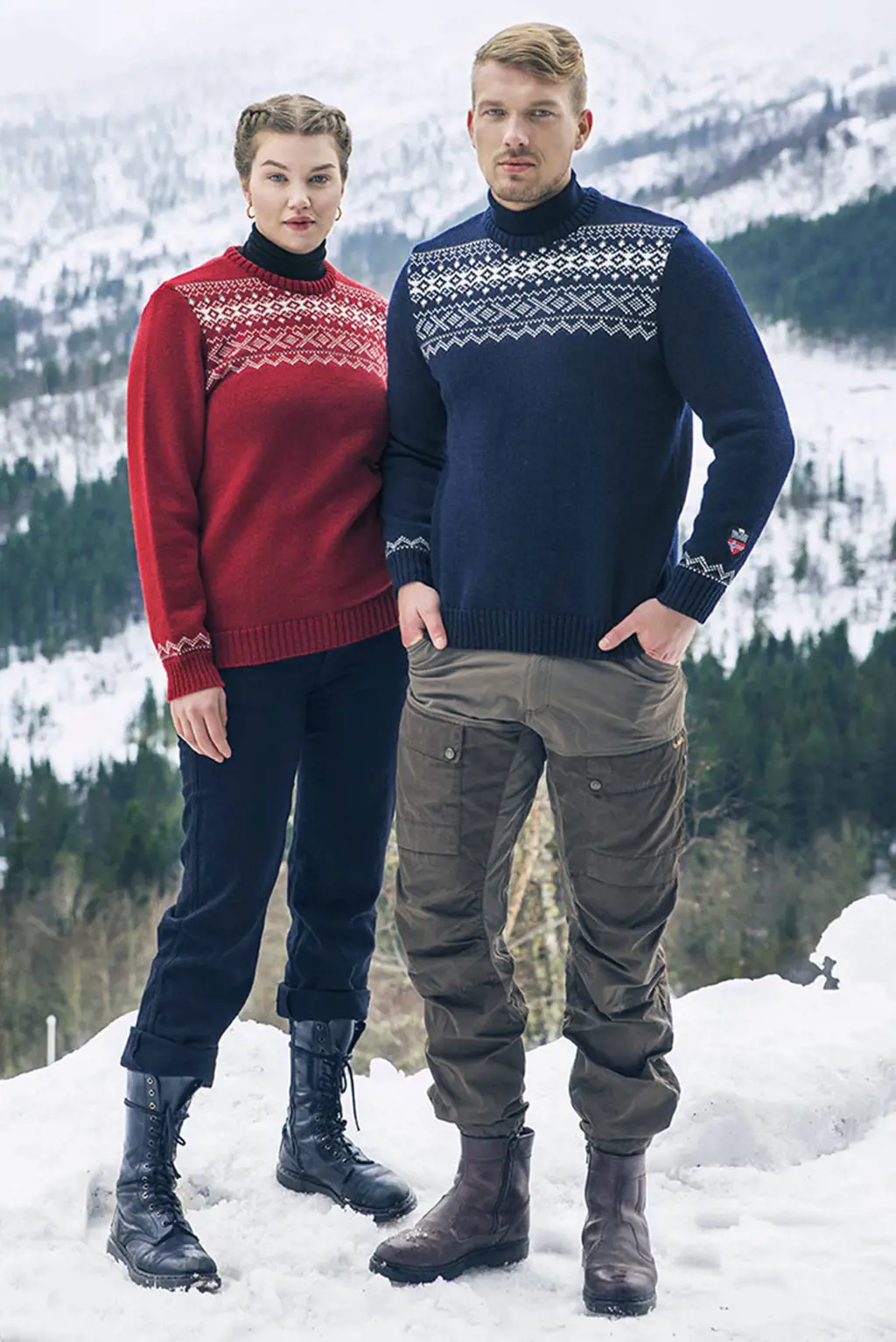
When packing for winter in Norway, it's essential to be well-prepared for the cold temperatures and varying weather conditions. Here are some essential clothing items that you should consider packing for your trip:
- Thermal Base Layers: Start with a good set of thermal base layers, including long-sleeve tops and bottoms made of merino wool or synthetic materials. These base layers will keep you warm by trapping heat close to your body and wicking away moisture.
- Insulated Jacket: A high-quality insulated jacket is a must-have for staying warm in Norway's winter weather. Look for a jacket with down or synthetic insulation and a waterproof or water-resistant outer layer to help protect you from snow and rain.
- Wool Sweaters: Norway is known for its wool production, so it's a good idea to pack a few wool sweaters. They are warm and breathable, making them perfect for layering under your jacket.
- Windproof and Waterproof Pants: Opt for windproof and waterproof pants to protect yourself from the elements. Look for pants with a good insulation layer for added warmth. These pants will keep you dry and comfortable, even if you encounter snowy or rainy conditions.
- Warm and Insulated Boots: Invest in a pair of warm and waterproof boots with good insulation. Opt for boots with thick soles that provide good traction on snow and ice. Remember to pack thermal socks to keep your feet warm and dry.
- Gloves and Mittens: Protect your hands from the cold with a good pair of gloves or mittens. Look for gloves that are waterproof and insulated. It's also a good idea to pack a liner pair of gloves or mittens that you can wear under your outer layer for added warmth.
- Hats and Beanies: Heat escapes from your head, so wearing a hat or beanie is crucial for staying warm. Look for a beanie made of wool or synthetic materials that can cover your ears as well.
- Scarves and Neck Warmers: Scarves and neck warmers are great for protecting your neck and face from cold winds. Look for ones made of wool or thermal materials that offer good insulation.
- Thermal Socks: Keep your feet warm and dry with thermal socks made of merino wool or synthetic materials. These socks will provide extra insulation and moisture-wicking properties.
- Gaiters: Gaiters are protective coverings that go over your shoes or boots and extend up to your lower leg. They provide an extra layer of protection against snow, rain, and cold winds, keeping your feet and lower legs warm and dry.
Remember to layer your clothing to trap heat more effectively. Layering allows you to adjust your body temperature as needed by adding or removing layers. This way, you can stay comfortable and warm throughout your winter adventure in Norway.
In conclusion, packing the right clothing items is crucial for staying warm and cozy during winter in Norway. Consider packing thermal base layers, insulated jackets, wool sweaters, windproof and waterproof pants, warm boots, gloves or mittens, hats or beanies, scarves or neck warmers, thermal socks, and gaiters. Layering your clothing and selecting the right materials will help you stay comfortable and prepared for the varying weather conditions in Norway.
Packing Essentials for a Windy Gap Adventure: What You Need to Bring
You may want to see also

Are there any specific items, such as thermals or down jackets, that are recommended for staying warm in Norway's winter weather?
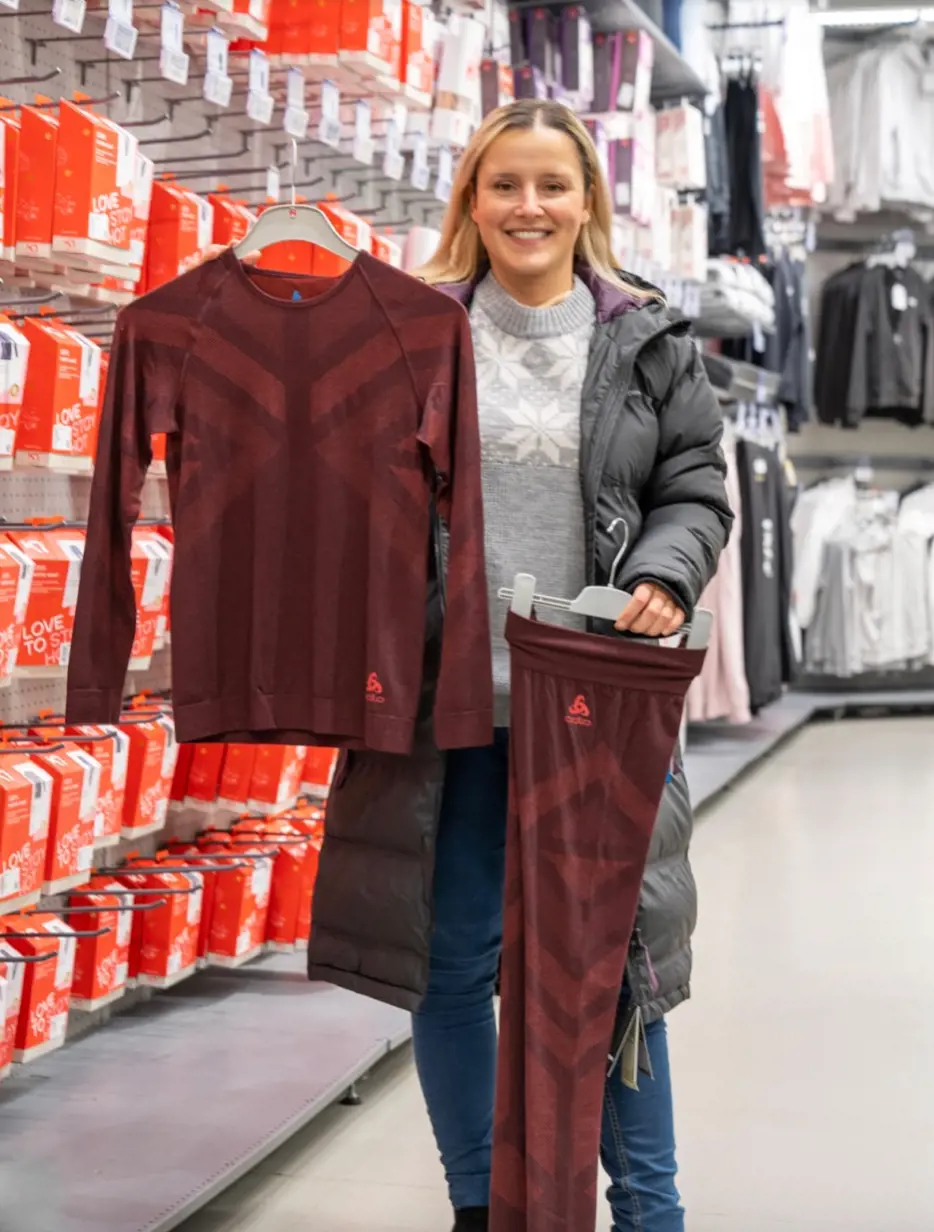
Norway is known for its extremely cold winter weather, with temperatures dropping well below freezing. If you're planning a trip to Norway during the winter months, it's essential to pack the right gear to stay warm and comfortable. There are several specific items that are highly recommended for staying warm in Norway's winter weather, including thermals and down jackets.
Thermals, also known as base layers, are an essential item for staying warm in cold weather. These are lightweight, moisture-wicking garments that are worn close to the skin. They help to trap heat close to the body and keep you warm by insulating against the cold air. It's best to choose thermal tops and bottoms made from merino wool or synthetic materials, as these fabrics are known for their insulating properties. Layering is key when it comes to staying warm, so wearing a thermal base layer underneath your regular clothes will provide an extra layer of warmth.
Another crucial item for staying warm in Norway's winter weather is a down jacket. Down jackets are filled with down feathers, which provide excellent insulation. They are lightweight, yet incredibly warm, making them perfect for cold climates. Look for a down jacket with a high fill power, as this indicates a higher quality of insulation. It's also important to choose a jacket that is windproof and has a water-resistant or waterproof outer layer to protect against the elements.
In addition to thermals and a down jacket, there are a few other items that are recommended for staying warm in Norway's winter weather. A good pair of insulated gloves is essential for keeping your hands warm, as well as a hat and scarf to protect your head and neck from the cold. It's also important to invest in a sturdy pair of insulated boots to keep your feet warm and dry. Look for boots with a thick, insulating lining and a waterproof outer material.
Layering is key when it comes to staying warm in cold weather, so it's important to have a few different layers of clothing that you can adjust as needed. A combination of thermals, sweaters, fleeces, and a down jacket will provide the necessary insulation to keep you warm in Norway's winter weather. It's also important to remember to wear moisture-wicking and breathable fabrics to prevent sweat from accumulating, as this can make you feel colder.
In conclusion, if you're planning a trip to Norway during the winter months, it's important to pack the right gear to stay warm in the cold weather. Thermals and down jackets are highly recommended for insulation and warmth. Additionally, don't forget accessories such as insulated gloves, hats, scarves, and boots. Remember to layer your clothing and choose moisture-wicking and breathable fabrics to ensure maximum comfort. With the right gear, you'll be able to stay warm and enjoy all that Norway has to offer during the winter.
Choosing the Right Size Silica Pack for Your Needs
You may want to see also

What footwear should be included in a winter packing list for Norway, considering potentially icy and snowy conditions?
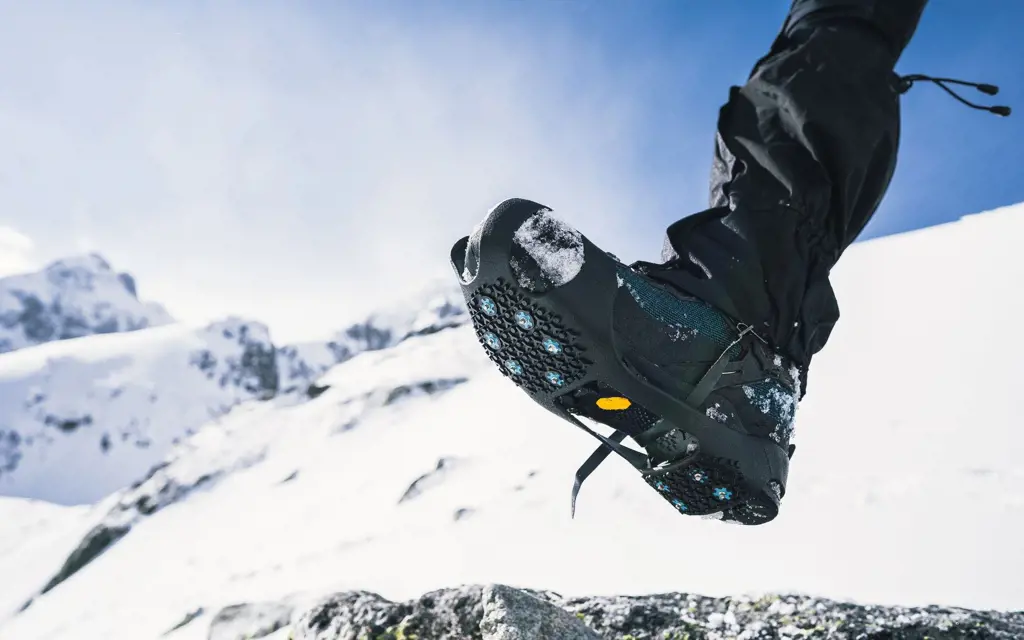
When visiting Norway during the winter months, it is essential to pack the right footwear to ensure your safety and comfort in potentially icy and snowy conditions. The right shoes will help you navigate the slippery terrain without risking any injuries. Here are some key footwear options that should be included in your winter packing list for Norway:
Insulated Waterproof Boots:
Investing in a good pair of insulated waterproof boots is crucial. Look for boots that are specifically designed for winter conditions, with a temperature rating that suits the average winter temperatures in Norway. These boots should have a sturdy sole with good traction to prevent you from slipping on icy surfaces.
Microspikes or Crampons:
Even with the right winter boots, there may be slippery patches of ice that require extra grip. Microspikes or crampons can be attached to your boots' soles to provide enhanced traction on icy surfaces. These are especially useful for hiking or walking on steep and icy terrain.
Woolen Socks:
In addition to the right boots, it is important to wear the right socks to keep your feet warm and dry. Opt for thick woolen socks that provide insulation and moisture-wicking properties. Wool retains warmth even when wet, making it an excellent choice for winter conditions.
Gaiters:
Gaiters are protective coverings that wrap around your lower legs and ankles. They help to keep snow out of your boots, ensuring your feet stay dry throughout the day. Gaiters are particularly useful when hiking in deep snow or when going off-trail in snow-covered areas.
Indoor Slipper Shoes:
In Norway, it is common for people to remove their outdoor footwear when entering homes or public spaces. To keep your feet comfortable indoors, pack a pair of lightweight slipper shoes. These can be easily slipped on and off, providing warmth and comfort when you are not wearing your outdoor boots.
Emergency Traction Devices:
If you plan on exploring remote areas or engaging in outdoor activities, it is wise to carry emergency traction devices. These compact devices can be quickly attached to your boots in case of unexpected icy conditions. They provide additional grip when needed and can be a lifesaver in slippery situations.
Remember, it is important to try on and break in your winter footwear before your trip to ensure a comfortable fit. You should also familiarize yourself with the proper technique for using microspikes or crampons, as well as emergency traction devices.
In conclusion, when packing for a winter trip to Norway, it is vital to include footwear that is suitable for potentially icy and snowy conditions. Insulated waterproof boots, microspikes or crampons, woolen socks, gaiters, indoor slipper shoes, and emergency traction devices are all key items to consider. By selecting the right footwear, you can confidently enjoy your winter adventures in Norway while staying safe and warm.
Essential Items to Pack for Your OBX Vacation
You may want to see also

Are there any specific accessories or gear that are necessary for winter activities in Norway, such as skiing or snowshoeing?

When it comes to winter activities in Norway, such as skiing or snowshoeing, having the right accessories and gear is crucial for a safe and enjoyable experience. Norway is known for its cold and snowy winters, so being well-prepared is essential. Here are some specific accessories and gear that are necessary for winter activities in Norway:
- Thermal Base Layers: A good set of thermal base layers is essential for staying warm in the cold weather. Look for base layers made of moisture-wicking and insulating materials, such as merino wool or synthetic fibers. These base layers will help regulate your body temperature and keep you dry.
- Insulated Jacket and Pants: To stay warm and protected from the cold winds, it's important to have a high-quality insulated jacket and pants. Look for jackets and pants that are waterproof and breathable, as they will keep you dry and comfortable during your activities. Additionally, make sure the jacket and pants have adjustable cuffs and hems to ensure a snug fit and prevent snow from entering.
- Hat and Gloves: Keeping your extremities warm is essential in cold temperatures. Invest in a good winter hat that covers your ears and is made of insulating material. For gloves, choose a pair that is waterproof, insulated, and allows for dexterity. Consider getting gloves with touchscreen compatibility, so you can still use your phone without removing your gloves.
- Ski/Snowshoe Boots: For skiing or snowshoeing, having proper footwear is crucial. Look for boots that are specifically designed for these activities, as they will have the necessary features such as ankle support, insulation, and a grippy sole. It's also important to ensure a proper fit to prevent blisters or discomfort during your winter adventures.
- Goggles/Sunglasses: Protecting your eyes from the glare of the snow and the wind is important to maintain visibility and eye comfort. Invest in a good pair of goggles or sunglasses that offer UV protection and have anti-fog features. Make sure they fit well and provide a clear vision even in low light conditions.
- Backpack: A backpack is a practical accessory to carry your essential items such as water, snacks, extra layers of clothing, and a first aid kit. Look for a backpack that is lightweight, durable, and has enough compartments to keep your belongings organized.
- Climbing Skins/Snowshoes: If you plan on going off-piste or exploring trails with deep snow, climbing skins or snowshoes are necessary to provide traction and prevent you from sinking into the snow. Climbing skins are adhesive strips that attach to the bottom of skis, while snowshoes are specially designed footwear with a wide surface area to distribute weight and prevent sinking.
In addition to these specific accessories and gear, it's also important to carry other essentials such as sunscreen, lip balm, and a map or GPS device to navigate your chosen routes. It's always a good idea to check the weather forecast and avalanche conditions before heading out, as well as informing someone about your plans and estimated return time.
By investing in the right accessories and gear, you can fully enjoy the winter activities in Norway while staying safe and comfortable. Remember to always prioritize safety and be prepared for the cold and unpredictable weather conditions.
The Essential Packing List for Governor's School: What to Bring for a Successful Experience
You may want to see also

Should I pack any specific skincare products or items to protect against the cold and dryness of Norway's winter climate?
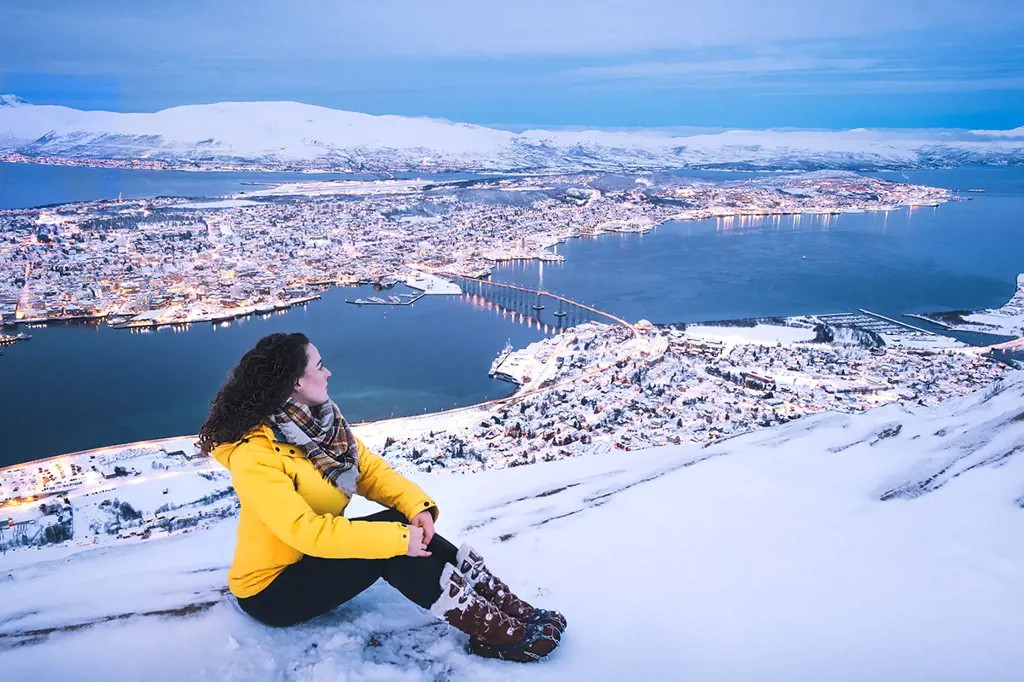
When traveling to Norway in the winter, it is important to be prepared for the cold and dry climate. The extreme temperatures and low humidity can have a significant impact on your skin, making it dry, flaky, and prone to irritation. To protect your skin from these harsh conditions, it is essential to pack specific skincare products and items that will help keep your skin nourished and moisturized.
- Moisturizer: One of the most important skincare products to pack for a winter trip to Norway is a good moisturizer. Look for a moisturizer that is rich and hydrating, as this will help prevent dryness and lock in moisture. Ingredients like hyaluronic acid, glycerin, and ceramides are beneficial for maintaining hydration in the skin.
- Lip balm: The cold weather can cause chapped and dry lips, so it's crucial to bring a lip balm with you. Opt for a lip balm that contains nourishing ingredients like shea butter or beeswax to protect and moisturize your lips. Apply it regularly throughout the day to keep your lips hydrated and prevent cracking.
- Hand cream: Our hands tend to get dry and cracked during the winter months, especially in cold climates. Bring a travel-sized hand cream with you to keep your hands moisturized and protected. Look for a hand cream that contains ingredients like coconut oil or shea butter, which will provide intense hydration and help repair any damage.
- Sunscreen: Although it may seem counterintuitive, it is essential to pack sunscreen when visiting Norway in the winter. The sun's rays can still be harsh, even in cold weather, and the snow can reflect the sun's rays, increasing the risk of sunburn. Choose a broad-spectrum sunscreen with an SPF of at least 30, and apply it to any exposed skin, including your face and hands.
- Facial mist: A facial mist can be a lifesaver when dealing with dry and dehydrated skin. Look for a mist that contains hydrating ingredients like rosewater or aloe vera. A quick spritz of facial mist throughout the day will help rehydrate your skin and give it a radiant glow.
- Humidifier: Consider bringing a portable humidifier to add moisture to the air in your hotel room or any other indoor space you spend a significant amount of time in. This will help counteract the dryness caused by indoor heating systems, making your skin less prone to dryness and maintaining its natural moisture balance.
In addition to these specific skincare products, there are a few other steps you can take to protect your skin during your winter trip to Norway:
- Drink plenty of water: Staying hydrated is essential for maintaining healthy skin. Be sure to drink plenty of water throughout the day to keep your skin hydrated from the inside out.
- Avoid hot showers: While it may be tempting to take hot showers to warm up, hot water can strip away the natural oils from your skin, making it more prone to dryness. Stick to lukewarm water and limit your shower time to prevent further dehydration.
- Layer your clothing: Wearing multiple layers of clothing will help trap heat and keep your body warm, reducing the impact of the cold on your skin.
- Protect your face and hands: Covering your face with a scarf and wearing gloves will provide an extra layer of protection against the cold and wind, helping to prevent dryness and chapping.
In conclusion, when traveling to Norway in the winter, it is crucial to prepare for the harsh cold and dry climate by packing specific skincare products and items. Moisturizer, lip balm, hand cream, sunscreen, facial mist, and a humidifier can all help protect your skin and keep it hydrated during your trip. Additionally, following some general skincare tips like drinking plenty of water, avoiding hot showers, layering your clothing, and protecting your face and hands will further help safeguard your skin from the winter elements.
Essential Nutrient-Rich Foods to Pack for Lunch During Pregnancy
You may want to see also
Frequently asked questions
When packing for winter in Norway, it's important to bring warm and layered clothing. This should include items such as thermal or woolen base layers, a thick insulated jacket, waterproof and windproof outer layers, woolen socks, gloves, a hat, and a scarf. It's also a good idea to pack sturdy waterproof boots to keep your feet dry and warm.
To stay warm in the Norwegian winter, you should dress in layers. Start with a thermal or woolen base layer close to your skin, then add a mid-layer such as a fleece or down jacket, and finish with a waterproof and windproof outer layer. This layering system allows you to easily adjust your clothing to your body temperature and the weather conditions. Don't forget to also wear warm and insulated accessories such as gloves, a hat, and a scarf to protect your extremities.
In addition to clothing, there are a few other items you should pack for winter in Norway. A good pair of sunglasses is essential to protect your eyes from the glare of the snow. It's also a good idea to bring a small hand warmer or pocket heater to keep your hands warm in case of extreme cold. Don't forget to pack a reusable water bottle to stay hydrated, as well as a portable charger for your electronic devices, as cold temperatures can drain batteries quickly. Lastly, it's always handy to have a waterproof and insulated backpack to carry your belongings while exploring the winter wonderland of Norway.







